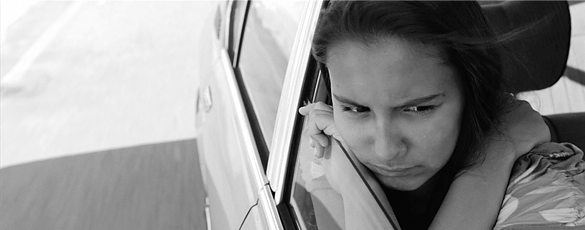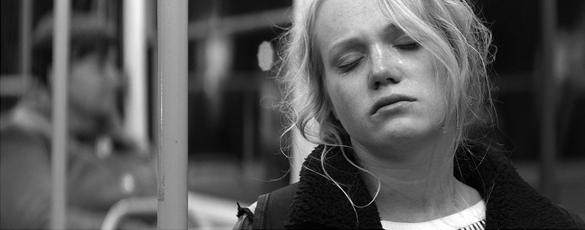Začiatok stránky, titulka:
Pokračovanie obsahu:
Who Is to Blame?
After the first five successful years since the Slovak Audiovisual Fund was established, Slovak cinema appears to be consolidated; the individual trends do alternate but they, nevertheless, remain quite stable on a broader time-frame. Nor did we experience any marked surprises in feature film in 2016, either.

It was probably The Red Captain (Červený kapitán, dir. Michal Kollár) that deviated most from the current forms of feature film in Slovakia, not only by focusing on a historical period quite untypical for Slovak film but, in particular, in the visual treatment and the extent of the use of special visual effects. Their appearance has been considerably professionalised since Immortalitas (2012) was made hence the audiences of The Red Captain could delight in a Bratislava which, to all extents and purposes, was not adequately captured in film due to the rapid decline in film production in the early 1990s.
But can we consider The Red Captain to be a surprise?
This paper includes a review of six Slovak and majority Slovak films or equal co-productions that were released into general distribution over the course of the previous year (including Nvota’s fairy tale Johanna’s Mystery/Johankino tajomstvo which actually received its première at the end of 2015 but it was screened exclusively in Cinema Lumière in Bratislava and was only distributed to other cinemas last year). Almost all the films from the six under review move consistently along one of two lines: either along the anti-communism line or the social drama line. The first is represented by The Red Captain, Agave (Agáva, dir. Ondrej Šulaj) and The Teacher (Učiteľka, dir. Jan Hřebejk), and the second by Little Feather (Pirko, dir. Lucia and Petr Klein Svoboda) and, in part, also by Stanko (dir. Rasťo Boroš). With a little exaggeration we could state that this collection (in which only Johanna’s Mystery diverges) plays into the hands of all the opponents of the current political regime. But in reality, nothing is ever that simple, so one should rather ask what the reviewed films really say about our past and present times. Do their images possess any power? And if they are to be critical (and most of them are), is their critical scalpel really constructive?
Of course, another question is what we understand as critique: conventional condemnation of what should be condemned or the process of revaluation and raising doubts. For instance, the teaching monster in Hřebejk’s film lacks almost any good qualities, the film underscores the abomination of communism and the snares of the Stockholm syndrome which is fully manifested in the scenes of the teacher-parent meeting based on the principle of a model little morality where the destroyed victims, a flippant rebel and a number of hesitant parents are supported mainly by obviously corrupted individuals.
The critical attitude of Little Feather is of a different nature. The motifs of two films – The Miracle (Zázrak, 2013) and Made in Ash (Až do mesta Aš, 2012) – come together in the film, and there is an evident effort to move them to a new stylistic form. However, while a certain stereotypicality of the plot-line in The Miracle and Made in Ash was redeemed by the emphasis on narrative by image, this attempt did not deliver so well for Little Feather. A visually and narratively refreshing digression from the usual Slovak variations of social drama, which looks promising, mars its reputation with the gaudy and too illustrative use of music and, at the same time, with the indeterminate moral attitude of its authors and the unclear border between condemnation and romanticisation (of drug addict outsiders and the world of luxury prostitution), or between demonisation (the sleazy hairy backs of old men raping the angelically alabaster heroine) and innocuous caricature (the strange hot-dog seller with excessive overbite).
The metaphor of a plant that blooms once in a lifetime and then dies finds its parallel in the destiny of the heroine of Agave who is to get to know love for the first and last time in the summer preceding “Victorious February”.1 However, the question arises as to whether such a metaphor is sufficient if we do not learn from the film what the values of the old world, which is about to be so bitterly destroyed, consist of – except for sitting at wine and verbally declaring one’s spontaneous relation to women. While The Teacher focuses on the abominable dimensions of communism as a system in which Party affiliation determines who gets to wield power and which establishes the predispositions for manipulation, Agave perceives communism as a metonymy, a foggy apocalypse to follow after a temporary idyll. Condemnation is here a matter of societal consensus and the cultural cliché familiar from fairy-tales and stories about wars and disasters where an apocalypse always follows such an idyll.
Even though Slovak filmmakers usually do not fail to agree that communism is a condemnable ideology, trivial anti-communism also causes harm – many currently criticise it for a dearth of sober arguments, the inability to separate the failings of actual communist regimes from the positive aspects of the idea of a social state, but also for the fact that simple and superficial anticommunism works to favour conspiracies and often deflects attention toward solutions that border on extremism. The blatant demonisation of The Teacher in this context will not serve any cause, but the melancholic fatalism that Ondrej Šulaj was inclined toward in his directing début might also appear as ineffective. Agave seeks to evoke a sensual atmosphere with colours and sounds, but it pays the price for the over-stereotypical image solutions, the “paper” dialogues and the scarcely credible acting performance of the main protagonist. Here and there the tragedy of human fates flashes through the narrative but only occasionally, as if the film needed to assure the viewer too much on which side evil crystallises.
Perceiving communism as a metonymy of the fictitious story is also characteristic of The Red Captain. This stifling detective story calls attention to the survival of communism even after its fall and to the efforts of the State Security to keep on controlling the seemingly democratic system – for instance via the corruption of the church. Thus, it develops a conspiratorial dot from the ending of The Teacher: the thesis that the rotten communism survives even today and uses the same manipulative practices.
However, most of the above films refer rather to mistrust in state institutions than to anti-communism. This also relates to the Slovak variations of social dramas from recent years; of the films under review it is, in particular, Little Feather where the mistrust is expressed by the heroine’s rejection of assistance from the state and the decision to live on the fringes of society. Thereby the heroine rejects the clearly demonic form of the state, represented by the staff of the children’s home, and also the kind face of the state which lifts the heroine from out of the pimps’ den, rehabilitates her, provides her with accommodation and a job – but does not ensure for her the adequately luxurious life that she still yearns for.

In essence, out of the films reviewed, only the road movie début Stanko sets itself apart from the tendentious romanticisation of everything that is outside the control (of state or patriarchal) power. And this is simply done: the question of the struggle with power is just not raised at all in this film. Instead, Stanko offers the story of a maladjusted petty fraudster and a Roma girl abandoned by her mother; they are on the road between Slovakia and Italy. The colour toning of the film in the style of the golden age of American road movies verges on kitsch, but the film wins through with its consistency of image and music dramaturgy, and also with its non-typical hero who may be understood as a symptom of the period (without the filmmakers looking for those who are to blame for the period).
I regard Stanko and The Red Captain as the most valuable Slovak feature films made last year. It is not difficult to come up with such a contention not just due to the unwillingness of the makers of those two films to clearly blame others (or the system) for everything bad that occurred to the protagonists, but also due to the fact that both films bet on much more credible narration than their competitors. If we were to evaluate Slovak film on the basis of The Teacher or Agave we could easily get the impression that it had returned to the era of schematic dialogues that are difficult to be played at a level higher than that of the actor’s first reading (as eventually The Teacher also shows illustratively). If we were to evaluate Slovak film on the basis of Little Feather and Johanna’s Mystery we would gain the impression that its sense for music dramaturgy is excessively conservative, even anaesthetically so. Moreover, the last-mentioned film suffers from the illogicality of the story or the motivations of the characters, and from the lack of imagination which is crucial for the fairy-tale world.
However, the value of The Red Captain and Stanko lies not only in a higher degree of inner consistency or a lesser degree of triviality, but also in the way they face up to the world and the message they bear for the viewer. While the other films nudge the viewer toward a passive drowning in helpless- ness and condemnation, or (like Little Feather) they offer an implausible rapid transformation from victim to manipulator, Kollár’s film emphasises the role of the individual, the personal enthusiasm or courage on which the rescue of moral values of the collective depends. Even though poor articulation of the dialogues does not increase the film’s comprehensibility and some characters might seem to be under-motivated, this message can be important if we do not just confine ourselves to comfortable identification with the hero searching for the truth, who will do “all the work” for us.
In turn, Stanko’s value consists in how the film smashes the usual image of the Slovak anti-hero from the periphery who takes life’s hard knocks with a poker face. Instead, Rasťo Boroš offers the image of a neurotic whose fear of failure is almost tangible throughout the entire film. Even though this might be unattractive or even tedious for the audiences, the film tries to arouse compassion for the hero, but also to teach him empathy. It does not seek to find out the roots of his misfortune or blame the system, it builds on basic human values. And so the maladjusted petty criminal Stanko shakes off his fear at the end of the film and, albeit belatedly, he refuses to accept the fact that he has betrayed an innocent girl. Because the way out of the crisis of humanity that most of the films in question point to is neither to blame the others or the state, nor to voluntarily accept the role of a predator. Both approaches would, rather, be a route leading to new totality. And the way the domestic political situation is currently developing could be a warning for us.
This work was supported by the Slovak Research and Development Agency under Contract no. APVV-0797-12.
1 The 1948 Czechoslovak coup d’etat in which the Communist Party of Czechoslovakia assumed undisputed control over the government of Czechoslovakia. (translator’s note)
Jana Dudková
Stanko. PHOTO: AH Production, Little Feather. PHOTO: Bontonfilm